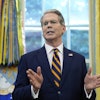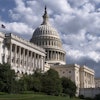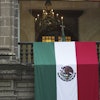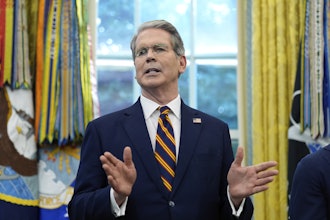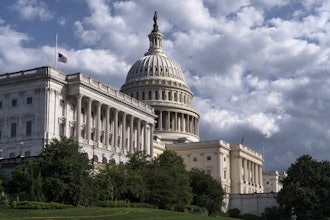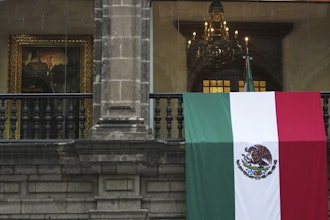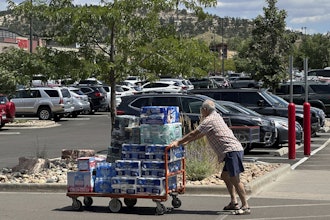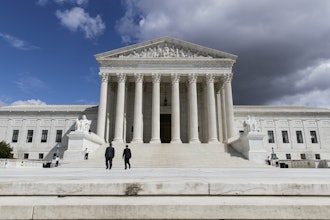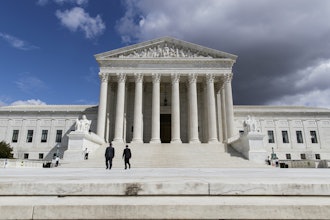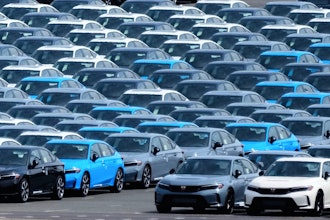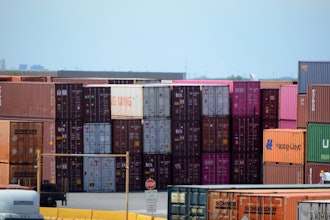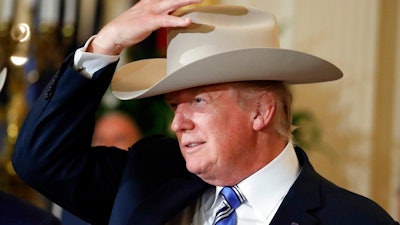
WASHINGTON (AP) — President Donald Trump vowed Monday to boost U.S. manufacturing by cutting the $64 billion trade deficit with Mexico as he showcased products made in all 50 states — everything from a fire truck to a baseball bat.
"No longer are we going to allow other countries to break the rules, to steal our jobs and drain our wealth," Trump said at a White House event that spilled from the East Room to the South Lawn.
Shortly after Trump's remarks, the U.S. trade representative released an 18-page report about its goals for updating the decades-old North American Free Trade Agreement with Canada and Mexico. In addition to reducing the trade deficit, the administration wants to insert a chapter on the digital economy into the deal. It also wants to strengthen labor and environmental obligations, as well as amending the rules of origin so that more of the products traded come from the United States and North America.
Facing an investigation into his campaign's ties with Russia and a tax and health care agenda struggling to make headway as quickly as promised, Trump is turning his focus to trade this week. Administration officials are to meet Wednesday with economic officials from China, a nation the president has accused of dumping steel on the global market to hurt U.S. steelmakers. The White House emphasis on trade follows a string of other recent theme weeks on energy, job-training and infrastructure that mostly failed to draw much attention away from the Russia inquiry.
The president took his time checking out products from all over the country: Trump donned a cowboy hat from Texas. He swung a baseball bat from Louisiana. And he even climbed into the cab of a Wisconsin-built fire truck and pretended to be a firefighter, saying, "Where's the fire? Where's the fire? Put it out fast!"
The new NAFTA objectives, a requirement to begin talks on updating the agreement in the next 30 days, contain the first specifics for a Trump administration that has made bold promises on trade. Trump has pledged to recover factory jobs and boost wages by crafting new trade deals. Supporters note that NAFTA enabled companies to charge cheaper prices for products that range from cars to vacuum cleaners, helping many U.S. consumers.
The president said he only seeks a level playing field for U.S. companies and workers, but "if the playing field was slanted a little bit toward us, I would accept that, also."
But the president has a conflicted relationship with global trade. His namesake clothing business depended on the work of low-wage workers living overseas, as does the fashion line of his daughter and White House aide, Ivanka Trump.
As of now, Ivanka Trump's firm continues to have its products made overseas. Her lawyer, Jamie Gorelick, said in a statement Monday that the president's daughter "has resigned from the company, does not control its operations, and has been advised that she cannot ask the government to act in an issue involving the brand in any way, constraining her ability to intervene personally."
Trump has blasted trade deficits as hampering the economy by sending money abroad. But the trade deficit has actually improved from $762 billion in 2006 to $505 billion last year, a change brought about largely because U.S. consumers cut back spending during the Great Recession. His administration already is pursuing multiple trade cases on individual products and is weighing whether to impose tariffs and quotas on foreign steel in hopes of curbing production in China, even though that country represents a fraction of U.S. steel imports.
The Mexican government said in a statement that the administration's NAFTA objectives will give greater clarity to the negotiations.
Chrystia Freeland, Canada's minister of foreign affairs, said, "NAFTA supports millions of middle class jobs" across North America and Canada welcomes the opportunity to add "progressive, free and fair approaches" to the pact.
Despite the report, it's still not clear exactly how Trump will renegotiate NAFTA to reduce the trade deficit, said Phil Levy, a senior fellow for the Chicago Council on Global Affairs and a business professor at Northwestern University.
"There's no detail," Levy said. "There's nothing in there where you could say, this is how we get rid of the trade deficit."
When NAFTA went into effect in 1994, the United States ran a small trade surplus in goods with Mexico and a slight deficit with Canada. But the size of the deficits steadily began to increase afterward.
By last year, the United States ran a $64 billion trade deficit with Mexico and a nearly $11 billion gap with Canada. Neither trade deficit is near its peak level. The trade deficit with Canada hit a high in 2008, while the trade gap with Mexico nearly reached $75 billion in 2007.

